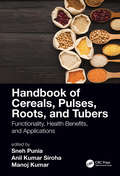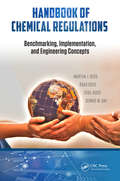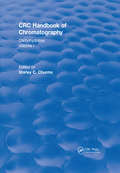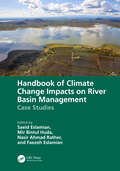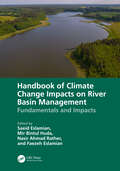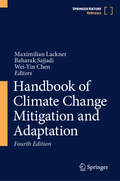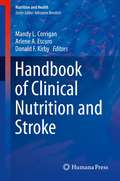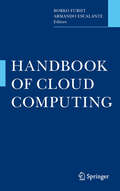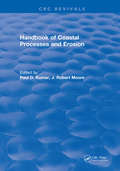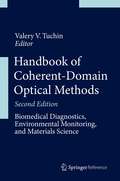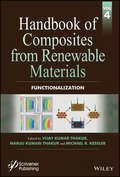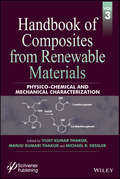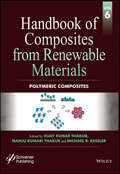- Table View
- List View
Handbook of Cereals, Pulses, Roots, and Tubers: Functionality, Health Benefits, and Applications
by Sneh PuniaCereals, pulses, roots, and tubers are major food sources worldwide and make a substantial contribution to the intake of carbohydrates, protein, and fiber, as well as vitamin E and B. The Handbook of Cereals, Pulses, Roots, and Tubers: Functionality, Health Benefits, and Applications provides information about commercial cereals, pulses, and their nutritional profile, as well as health benefits and their food and non-food applications. Split into four sections, this handbook covers all the recent research about the related crops and outlines matters needing further research in the field of agriculture sciences. Both qualitative and quantitative analysis of nutrients and bio-actives, and their beneficial effects on human health, are highlighted in this book. The conclusions drawn and future perspectives proposed in each chapter will also help researchers to take more focused approaches. FEATURES Covers the full spectrum of cereals, pulses, roots, and tubers grain production, processing, and their use for foods, feeds, fuels, and industrial materials, and other uses Contains the latest information from grain science professionals and food technologists alike Provides comprehensive knowledge on the nutritional and non-nutritional aspects of cereals, pulses, and tubers Discusses the latest development in modification of native starch Provides information in enhancing shelf life and its utilization in phytochemical rich product development The result of various well-versed researchers across the globe sharing their knowledge and experience, this handbook will be a valuable resource for students, researchers, and industrial practioners who wish to enhance their knowledge and insights on cereals, pulses, roots, and tubers.
Handbook of Charged Particle Optics
by Jon OrloffWith the growing proliferation of nanotechnologies, powerful imaging technologies are being developed to operate at the sub-nanometer scale. The newest edition of a bestseller, the Handbook of Charged Particle Optics, Second Edition provides essential background information for the design and operation of high resolution focused probe instruments. The book’s unique approach covers both the theoretical and practical knowledge of high resolution probe forming instruments. The second edition features new chapters on aberration correction and applications of gas phase field ionization sources. With the inclusion of additional references to past and present work in the field, this second edition offers perfectly calibrated coverage of the field’s cutting-edge technologies with added insight into how they work. Written by the leading research scientists, the second edition of the Handbook of Charged Particle Optics is a complete guide to understanding, designing, and using high resolution probe instrumentation.
Handbook of Chemical Regulations: Benchmarking, Implementation, and Engineering Concepts
by Martha J. Boss Brad Boss Cybil Boss Dennis W. DayThe first book of its kind, Handbook of Chemical Regulations: Benchmarking, Implementation, and Engineering Concepts introduces the concept of global harmonization and interlinks between regulations and examines the reasons behind major requirements for chemical manufacture, article production, and distribution, importation, and usage. A compendium
Handbook of Chemicals and Safety
by T.S.S. DikshithA comprehensive resource, this volume offers a tool for the management of a range of chemical substances commonly used, handled, stored, transported, and disposed of as wastes. The substances include industrial solvents, pesticides, metals, air pollutants, toxic gases, drugs, and other items. Information supplied includes the chemical abstract system (CAS) number, IUPAC name, molecular formula, synonyms and trade names, use and exposure, toxicity and health effects, and carcinogen factors. Also included is information on exposure limits, methods of proper storage, and waste disposal.
Handbook of Chromatography Vol I: Carbohydrates (CRC Press Revivals)
by Shirley C. ChurmsThis handbook is intended to serve as a working manual and reference book for carbohydrate chemists and biochemists using the chromatographic methods that are indispensable in this field. Emphsis is on newer methods, such as high-performance liquid chromatography (HPLC) and other automated liquid chromatography systems; and the material included was compiled mainly from literature published during the years 1970 to 1978. Data appearing in Volumes I and II of the Handbook of Chromatography are not repeated here, but references to relevant tables in Volumes I and II are given at the start of corresponding sections of this handbook. In some cases material published before 1970 that was omitted from Volumes I and II of the series is included here: this applies particularly to the sections dealing with paper chromatography and electrophoresis.
Handbook of Climate Change Across the Food Supply Chain (Climate Change Management)
by Walter Leal Filho Marina Kovaleva Ilija Djekic Sergiy SmetanaThis book presents climate change as a global phenomenon which affects the entire food chain. Many studies analyzing environmental impacts of food systems confirm significant effects of food production on climate change. Most of them associate primary production with emission of greenhouse gasses identified as one of the causes resulting in warming the atmosphere and global climate effects. A wider perspective shows that the food chains start at farms with consumers being at the end of the pipeline. This approach emphasizes the role of the entire food chain highlighting different kinds of environmental impacts affecting climate change. On the other side, temperature changes and variations of precipitation patterns, together with extreme weather events and water reduction, are recognized as predictors for producing less food, decreased food quality, new food safety risks, biodiversity losses, and depletion of resources associated with food production in modified circumstances. Last but not least, these effects introduce new threats known as food security where some assumptions stress that almost one billion of people are hungry not receiving enough food as a result of climate changes. As a result, the UN highlights the need for combating climate change and promotes sustainable (food) consumption and production. Based on the perceived need to promote and disseminate information on climate change related to food system, the “Handbook of Climate change across the food supply chain” is being produced. The publication compiles information, experiences, practical initiatives, and projects around the subject matter and makes it available to a wide audience. It is expected that the “Handbook of Climate change across the food supply chain” makes many benefits of climate service clearer and, inter alia, leads to an increase in the demand for such important services.
Handbook of Climate Change Impacts on River Basin Management: Case Studies
by Saeid Eslamian, Mir Bintul Huda, Nasir Ahmad Rather, and Faezeh EslamianClimate change not only involves rising temperatures but it can also alter the hydro-meteorological parameters of a region and the corresponding changes emerging in the various biotic or abiotic environmental features.One of the results of climate change has been the impact on the sediment yield and its transport. These changes have implications for various other environmental components, particularly soils, water bodies, water quality, land productivity, sedimentation processes, glacier dynamics, and risk management strategies to name a few.This volume presents a diverse collection of case studies from researchers across the globe examining the impacts of climate change on river basin management in various geographical, hydrological, and socioeconomic contexts. The case studies yield important insights that can inform strategies to build resilience and adapt river basins to a changing climate.
Handbook of Climate Change Impacts on River Basin Management: Fundamentals and Impacts
by Saeid Eslamian, Mir Bintul Huda, Nasir Ahmad Rather, and Faezeh EslamianClimate change not only involves rising temperatures but it can also alter the hydro-meteorological parameters of a region and the corresponding changes emerging in the various biotic or abiotic environmental features.One of the results of climate change has been the impact on the sediment yield and its transport. These changes have implications for various other environmental components, particularly soils, water bodies, water quality, land productivity, sedimentation processes, glacier dynamics, and risk management strategies to name a few.This volume provides an overview of the fundamental processes and impacts of climate change on river basin management and examines issues related to soil erosion, sedimentation, and contaminants, as well as rainfall-runoff modeling and flood mitigation strategies. It also includes coverage of climate change fundamentals as well as chapters on related global treaties and policies.
Handbook of Climate Change Impacts on River Basin Management: Technology, Innovations and Management Practices
by Saeid Eslamian, Mir Bintul Huda, Nasir Ahmad Rather, and Faezeh EslamianClimate change not only involves rising temperatures but it can also alter the hydro-meteorological parameters of a region and the corresponding changes emerging in the various biotic or abiotic environmental features.One of the results of climate change has been the impact on the sediment yield and its transport. These changes have implications for various other environmental components, particularly soils, water bodies, water quality, land productivity, sedimentation processes, glacier dynamics, and risk management strategies to name a few.This volume provides an examination of the technological approaches to water management, and the practical applications for remote sensing, satellite image processing, and advanced statistical methods, all which can be utilized to predict, monitor, and manage the effects of climate change on river basins.
Handbook of Climate Change Mitigation and Adaptation
by Maximilian Lackner Wei-Yin Chen Baharak SajjadiNow in its 4th, extended edition, this completely revised and significantly expanded handbook addresses important new research findings and the global need for action related to climate change in its two most relevant aspects: mitigation and adaptation.There is a growing consensus that anthropogenic activities have been driving global climate change, and the consequence will be catastrophic for civilization. Reducing the 37.1 billion metric tons of CO2 produced annually (2017 global emissions) along with other greenhouse gases, particularly methane, has become a leading grand challenge and the pursuit of sustainable energy, environments, and economies is a complex issue affecting the daily life of every citizen.In this 4th edition, readers will find new chapters covering the causes and impacts of global warming, the climate change impacts on health, biodiversity, and the economy, and emerging technologies for climate change mitigation. Particular attention is given to topics such as wildfire threats, ocean acidification, coral bleaching, sea level rise, and permafrost thaw. The latest research on sustainable aviation fuels, carbon mineralization, and smart cities is also covered in this new edition, as well as topics like sustainable building design, climate-resistant building materials, and sustainable agriculture. The Handbook of Climate Change Mitigation and Adaptation collates information in this multi-disciplinary area, providing readers with a comprehensive overview of the scientific background and current and emerging technologies. Intended for an interdisciplinary, global audience of researchers and decision-makers at universities and in industry, it covers climate change models; established, mature, and promising future technologies and ideas; the impact of climate change; strategies for dealing with global warming; the related political frameworks; and climate education.
Handbook of Clinical Nutrition and Stroke
by Arlene A. Escuro Donald F. Kirby Mandy L. CorriganHandbook of Clinical Nutrition and Stroke is a comprehensive reference on nutrition for the multidisciplinary team caring for stroke patients. Targeting physicians, nurse practitioners, clinical dietitians, and advanced allied health and medical students, this volume provides an introduction on the different types of stroke, associated risk factors, and uniquely featured global perspectives on stroke. In addition to discussing stroke risk factors, the book expands upon treatment and management from the acute care setting through rehabilitation, captures the lifespan of patients affected by stroke, and discusses the progression of the nutrition care plan. Containing the most up-to-date, evidence based information currently available, Handbook of Clinical Nutrition and Stroke is a valuable resource for clinicians working with the stroke population.
Handbook of Cloud Computing
by Borko Furht Armando EscalanteCloud computing has become a significant technology trend. Experts believe cloud computing is currently reshaping information technology and the IT marketplace. The advantages of using cloud computing include cost savings, speed to market, access to greater computing resources, high availability, and scalability. Handbook of Cloud Computing includes contributions from world experts in the field of cloud computing from academia, research laboratories and private industry. This book presents the systems, tools, and services of the leading providers of cloud computing; including Google, Yahoo, Amazon, IBM, and Microsoft. The basic concepts of cloud computing and cloud computing applications are also introduced. Current and future technologies applied in cloud computing are also discussed. Case studies, examples, and exercises are provided throughout. Handbook of Cloud Computing is intended for advanced-level students and researchers in computer science and electrical engineering as a reference book. This handbook is also beneficial to computer and system infrastructure designers, developers, business managers, entrepreneurs and investors within the cloud computing related industry.
Handbook of Coastal Processes and Erosion
by Paul D. KomarThe objective of this book is to focus on the physical processes that cause coastal erosion.Many scientists and engineers have focused their research on the entire range of physical processes from the waves and the currents in the nearshore to the response of the beach, via sand transport, resulting in a changing coastal morphology. Of these many processes, this book focuses only on those which directly relate the generation of coastal erosion. Some chapters deal exclusively with the physical processes, while others provide examples of erosion problems although most of the chapter topics have clear implications for issues of coastal-zone management, these issues are not belaboured as several other books are already available in this area. The objective is to provide state-of-the-art presentation of the science of coastal erosion processes.
Handbook of Cognitive Task Design (Human Factors And Ergonomics Ser.)
by Erik HollnagelThis Handbook serves as a single source for theories, models, and methods related to cognitive task design. It provides the scientific and theoretical basis required by industrial and academic researchers, as well as the practical and methodological guidance needed by practitioners who face problems of building safe and effective human-technology s
Handbook of Cognitive and Autonomous Systems for Fire Resilient Infrastructures
by Glenn Corbett Mz NaserThis handbook aims at modernizing the current state of civil engineering and firefighting, especially in this era where infrastructures are reaching new heights, serving diverse populations, and being challenged by unique threats. Its aim is to set the stage toward realizing contemporary, smart, and resilient infrastructure.The Handbook of Cognitive and Autonomous Systems for Fire Resilient Infrastructures draws convergence between civil engineering and firefighting to the modern realm of interdisciplinary sciences (i.e., artificial intelligence, IoT, robotics, sensing, and human psychology). As such, this work aims to revolutionize the current philosophy of design for one of the most notorious extreme events: fire. Unlike other publications, which are narrowed to one specific research area, this handbook cultivates a paradigm in which critical aspects of structural design, technology, and human behavior are studied and examined through chapters written by leaders in their fields. This handbook can also serve as a textbook for graduate and senior undergraduate students in Civil, Mechanical, and Fire Protection engineering programs as well as for students in Architectural and social science disciplines. Students, engineers, academics, professionals, scientists, firefighters, and government officials involved in national and international societies such as the American Society of Civil Engineers (ASCE), Society of Fire Protection Engineers (SFPE), National Fire Protection Association (NFPA), and Institute of Electrical and Electronics Engineers (IEEE), among others, will benefit from this handbook.
Handbook of Coherent-Domain Optical Methods
by Valery V. TuchinThis Handbook provides comprehensive coverage of laser and coherent-domain methods as applied to biomedicine, environmental monitoring, and materials science. Worldwide leaders in these fields describe the fundamentals of light interaction with random media and present an overview of basic research. The latest results on coherent and polarization properties of light scattered by random media, including tissues and blood, speckles formation in multiple scattering media, and other non-destructive interactions of coherent light with rough surfaces and tissues, allow the reader to understand the principles and applications of coherent diagnostic techniques. The expanded second edition has been thoroughly updated with particular emphasis on novel coherent-domain techniques and their applications in medicine and environmental science. Volume 1 describes state-of-the-art methods of coherent and polarization optical imaging, tomography and spectroscopy; diffusion wave spectroscopy; elastic, quasi-elastic and inelastic light scattering spectroscopy and imaging; digital holographic microscopy, the Fourier transform light scattering method, and coherent diffractive imaging; wavefront sensing, aberration measurement and adaptive optics for ophthalmology; and laser remote sensing. Volume 2 presents the new and growing field of coherent optics in optical coherence tomography (OCT). Various applications of OCT and confocal microscopy, including biomedical endoscopy, are discussed. A special section covers Mueller matrix polarimetry, nonlinear laser fluorescence spectroscopy, and triplet-triplet annihilation assisted upconversion as optical tools for probing the physical parameters of materials and natural organic compounds.
Handbook of Compliant Mechanisms
by Larry L. Howell Spencer P. Magleby Brian M. OlsenA fully illustrated reference book giving an easy-to-understand introduction to compliant mechanismsA broad compilation of compliant mechanisms to give inspiration and guidance to those interested in using compliant mechanisms in their designs, the Handbook of Compliant Mechanisms includes graphics and descriptions of many compliant mechanisms. It comprises an extensive categorization of devices that can be used to help readers identify compliant mechanisms related to their application. It also provides chapters on the basic background in compliant mechanisms, the categories of compliant mechanisms, and an example of how the Compendium can be used to facilitate compliant mechanism design.Fully illustrated throughout to be easily understood and accessible at introductory levelsCovers all aspects pertaining to classification, elements, mechanisms and applications of compliant mechanismsSummarizes a vast body of knowledge in easily understood diagrams and explanations Helps readers appreciate the advantages that compliant mechanisms have to offerPractical approach is ideal for potential practitioners who would like to realize designs with compliant mechanisms, members and elementsBreadth of topics covered also makes the book a useful reference for more advanced readersIntended as an introduction to the area, the Handbook avoids technical jargon to assist non engineers involved in product design, inventors and engineers in finding clever solutions to problems of design and function.
Handbook of Composites from Renewable Materials, Biodegradable Materials
by Vijay Kumar Thakur Manju Kumari Thakur Michael R. KesslerThe Handbook of Composites From Renewable Materials comprises a set of 8 individual volumes that brings an interdisciplinary perspective to accomplish a more detailed understanding of the interplay between the synthesis, structure, characterization, processing, applications and performance of these advanced materials. The handbook covers a multitude of natural polymers/ reinforcement/ fillers and biodegradable materials. Together, the 8 volumes total at least 5000 pages and offers a unique publication. This 5th volume Handbook is solely focused on Biodegradable Materials. Some of the important topics include but not limited to: Rice husk and its composites; biodegradable composites based on thermoplastic starch and talc nanoparticles; recent progress in biocomposites of biodegradable polymer; microbial polyesters: production and market; biodegradable and bio absorbable materials for osteosynthesis applications; biodegradable polymers in tissue engineering; composites based on hydroxyapatite and biodegradable polylactide; biodegradable composites; development of membranes from bio-based materials and their applications; green biodegradable composites based on natural fibers; fully biodegradable all-cellulose composites; natural fiber composites with bio-derivative and/or degradable polymers; synthetic biodegradable polymers for bone tissue engineering; polysaccharides as green biodegradable platforms for building-up electroactive composite materials; biodegradable polymer blends and composites from seaweeds; biocomposites scaffolds derived from renewable resources for bone tissue repair ; pectin-based composites; recent advances in conductive composites based on biodegradable polymers for regenerative medicine applications; biosynthesis of PHAs and their biomedical applications; biodegradable soy protein isolate/poly (vinyl alcohol) packaging films and biodegradability of bio-based polymeric materials in natural environment.
Handbook of Composites from Renewable Materials, Design and Manufacturing
by Vijay Kumar Thakur Manju Kumari Thakur Michael R. KesslerThe Handbook of Composites From Renewable Materials comprises a set of 8 individual volumes that brings an interdisciplinary perspective to accomplish a more detailed understanding of the interplay between the synthesis, structure, characterization, processing, applications and performance of these advanced materials. The handbook covers a multitude of natural polymers/ reinforcement/ fillers and biodegradable materials. Together, the 8 volumes total at least 5000 pages and offers a unique publication. This 2nd volume of the Handbook is solely focused on the Design and Manufacturing of renewable materials. Some of the important topics include but not limited to: design and manufacturing of high performance green composites; manufacturing of high performance biomass-based polyesters by rheological approach; components design of fibrous composite materials; design and manufacturing of bio-based sandwich structures; design and manufacture of biodegradable products from renewable resources; manufacturing and characterization of quicklime filled metal alloy composites for single row deep groove ball bearing; manufacturing of composites from chicken feathers and poly (vinyl chloride); production of porous carbons from resorcinol-formaldehyde gels: applications; composites using agricultural wastes; manufacturing of rice wastes-based natural fiber polymer composites from thermosetting vs. thermoplastic matrices; thermoplastic polymeric composites; natural fiber reinforced PLA composites; rigid closed-cell PUR foams containing polyols derived from renewable resources; preparation and application of the composite from alginate; recent developments in biocomposites of bombyx mori silk fibroin; design and manufacturing of natural fiber/ synthetic fiber reinforced polymer hybrid composites; natural fibre composite strengthening solution for structural beam component for enhanced flexural strength; high pressure resin transfer molding of epoxy resins from renewable sources; cork based structural composites; the use of wheat straw as an agricultural waste in composites for semi-structural applications and design/ manufacturing of sustainable composites.
Handbook of Composites from Renewable Materials, Functionalization
by Vijay Kumar Thakur Manju Kumari Thakur Michael R. KesslerThe Handbook of Composites From Renewable Materials comprises a set of 8 individual volumes that brings an interdisciplinary perspective to accomplish a more detailed understanding of the interplay between the synthesis, structure, characterization, processing, applications and performance of these advanced materials. The handbook covers a multitude of natural polymers/ reinforcement/ fillers and biodegradable materials. Together, the 8 volumes total at least 5000 pages and offers a unique publication. This 4th volume of the Handbook is solely focused on the Functionalization of renewable materials. Some of the important topics include but not limited to: Chitosan-based bio sorbents: oil spill clean-up by textiles; pyridine and bipyridine end-functionalized polylactide; functional separation membranes from chitin and chitosan derivatives; acrylated epoxidized flaxseed oil bio-resin and its biocomposites; encapsulation of inorganic renewable nanofiller; chitosan coating on textile fibers for functional properties; surface functionalization of cellulose whiskers for nonpolar composites; impact of chemical treatment and the manufacturing process on mechanical, thermal and rheological properties of natural fibers based composites; bio-polymers modification; review on fibers from natural resources; strategies to improve the functionality of starch based films; the effect of gamma-radiation on biodegradability of natural fibers; surface functionalization through vapor-phase assisted surface polymerization (VASP) on natural materials from agricultural by-products; okra bast fiber as potential reinforcement element of biocomposites; silane coupling agent used in natural fiber/plastic composites; composites of olefin polymer /natural fibers: the surface modifications on natural fibers; surface functionalization of biomaterials; thermal and mechanical behaviors of bio-renewable fibres based polymer composites; natural and artificial diversification of starch; role of radiation and surface modification on bio-fiber for reinforced polymer composites.
Handbook of Composites from Renewable Materials, Nanocomposites: Advanced Applications
by Vijay Kumar Thakur Manju Kumari Thakur Michael R. KesslerThe Handbook of Composites From Renewable Materials comprises a set of 8 individual volumes that brings an interdisciplinary perspective to accomplish a more detailed understanding of the interplay between the synthesis, structure, characterization, processing, applications and performance of these advanced materials. The handbook covers a multitude of natural polymers/ reinforcement/ fillers and biodegradable materials. Together, the 8 volumes total at least 5000 pages and offers a unique publication.This 8th volume of the Handbook is solely focused on the Nanocomposites: Advanced Applications. Some of the important topics include but not limited to: virgin and recycled polymers applied to advanced nanocomposites; biodegradable polymer-carbon nanotube composites for water and wastewater treatment; eco-friendly nanocomposites of chitosan with natural extracts, antimicrobial agents and nanometals; controllable generation of renewable nanofibrils from green materials and their application in nanocomposites; nanocellulose and nanocellulose composites; poly (lactic acid) biopolymer composites and nanocomposites for biomedical and biopackaging applications; impact of nanotechnology in water treatment: carbon nanotube and graphene; nanomaterials in energy generation; sustainable green nanocomposites from bacterial bioplastics for food packaging applications; PLA-nanocomposites: a promising material for future from renewable resources; bio-composites from renewable resources: preparation and applications of chitosan-clay nanocomposites; nano materials: an advanced and versatile nano additive for kraft and paper industries; composites and nanocomposites based on polylactic acid obtaining; cellulose-containing scaffolds fabricated by electrospinning: applications in tissue engineering and drug delivery; biopolymer-based nanocomposites for environmental applications; calcium phosphate nanocomposites for biomedical and dental applications: recent developments; chitosan-metal nanocomposites: synthesis, characterization and applications; multi-carboxyl functionalized nano-cellulose/nano-bentonite composite for the effective removal and recovery of metal ions; biomimetic gelatin nanocomposite as a scaffold for bone tissue repair; natural starches-blended ionotropically-gelled microparticles/beads for sustained drug release and ferrogels: smart materials for biomedical and remediation applications.
Handbook of Composites from Renewable Materials, Nanocomposites: Science and Fundamentals
by Vijay Kumar Thakur Manju Kumari Thakur Michael R. KesslerThe Handbook of Composites From Renewable Materials comprises a set of 8 individual volumes that brings an interdisciplinary perspective to accomplish a more detailed understanding of the interplay between the synthesis, structure, characterization, processing, applications and performance of these advanced materials. The handbook covers a multitude of natural polymers/ reinforcement/ fillers and biodegradable materials. Together, the 8 volumes total at least 5000 pages and offers a unique publication.This 7th volume Handbook is solely focused on Nanocomposites: Science and Fundamentals. Some of the important topics include but not limited to: preparation, characterization and applications of nano materials from renewable resources; hydrogels and its nanocomposites from renewable resources: preparation of chitin-based nanocomposite materials through gelation with ionic liquid; starch based bionanocomposites; biorenewable nanofiber and nanocrystal; investigation of wear characteristics of dental composite reinforced with rice husk derived nanosilica filler particles; performance of regenerated cellulose/vermiculite nanocomposites fabricated via ionic liquid; preparation, structure, properties and interactions of the PVA/cellulose composites; green composites with cellulose nano-reinforcements; biomass composites from bamboo-based micro/nano fibers; synthesis and medicinal properties of polycarbonates and resins from renewable sources; nanostructured polymer composites with modified carbon nanotubes; organic-inorganic nanocomposites derived from polysaccharides; natural polymer based nanocomposites; cellulose whisker based green polymer composites; poly (lactic acid) nanocomposites reinforced with different additives; nanocrystalline cellulose; halloysite based bionanocomposites; nanostructurated composites based on biodegradable polymers and silver nanoparticles; starch-based biomaterials and nanocomposites; green nanocomposites based on PLA and natural organic fillers; chitin and chitosan based nanocomposites.
Handbook of Composites from Renewable Materials, Physico-Chemical and Mechanical Characterization
by Vijay Kumar Thakur Manju Kumari Thakur Michael R. KesslerThe Handbook of Composites From Renewable Materials comprises a set of 8 individual volumes that brings an interdisciplinary perspective to accomplish a more detailed understanding of the interplay between the synthesis, structure, characterization, processing, applications and performance of these advanced materials. The handbook covers a multitude of natural polymers/ reinforcement/ fillers and biodegradable materials. Together, the 8 volumes total at least 5000 pages and offers a unique publication. This 3rd volume of the Handbook is solely focused on the Physico-Chemical and Mechanical Characterization of renewable materials. Some of the important topics include but not limited to: structural and biodegradation characterization of supramolecular PCL/HAP nano-composites; different characterization of solid bio-fillers based agricultural waste material; poly (ethylene-terephthalate) reinforced with hemp fibers; poly (lactic acid) thermoplastic composites from renewable materials; chitosan –based composite materials: fabrication and characterization; the use of flax fiber reinforced polymer (FFRP) composites in the externally reinforced structures for seismic retrofitting monitored by transient thermography and optical techniques; recycling and reuse of fiber reinforced polymer wastes in concrete composite materials; analysis of damage in hybrid composites subjected to ballistic impacts; biofiber reinforced acrylated epoxidized soybean oil (AESO) biocomposites; biopolyamides and high performance natural fiber-reinforced biocomposites; impact of recycling on the mechanical and thermo-mechanical properties of wood fiber based HDPE and PLA composites; lignocellulosic fibers composites: an overview; biodiesel derived raw glycerol to value added products; thermo-mechanical characterization of sustainable structural composites; novel pH sensitive composite hydrogel based on functionalized starch/clay for the controlled release of amoxicillin; preparation and characterization of biobased thermoset polymers from renewable resources; influence of natural fillers size and shape into mechanical and barrier properties of biocomposites; composite of biodegradable polymer blends of PCL/PLLA and coconut fiber - the effects of ionizing radiation; packaging composite materials from renewable resources; physicochemical properties of ash based geopolymer concrete; a biopolymer derived from castor oil polyurethane; natural polymer based biomaterials; physical and mechanical properties of polymer membranes from renewable resources
Handbook of Composites from Renewable Materials, Polymeric Composites
by Vijay Kumar Thakur Manju Kumari Thakur Michael R. KesslerThe Handbook of Composites From Renewable Materials comprises a set of 8 individual volumes that brings an interdisciplinary perspective to accomplish a more detailed understanding of the interplay between the synthesis, structure, characterization, processing, applications and performance of these advanced materials. The handbook covers a multitude of natural polymers/ reinforcement/ fillers and biodegradable materials. Together, the 8 volumes total at least 5000 pages and offers a unique publication. This 6th volume Handbook is solely focused on Polymeric Composites. Some of the important topics include but not limited to: Keratin as renewable material for developing polymer composites; natural and synthetic matrices; hydrogels in tissue engineering; smart hydrogels: application in bioethanol production; principle renewable biopolymers; application of hydrogel biocomposites for multiple drug delivery; nontoxic holographic materials; bioplasticizer - epoxidized vegetable oils-based poly (lactic acid) blends and nanocomposites; preparation, characterization and adsorption properties of poly (DMAEA) – cross-linked starch gel copolymer in waste water treatments; study of chitosan crosslinking hydrogels for absorption of antifungal drugs using molecular modelling; pharmaceutical delivery systems composed of chitosan; eco-friendly polymers for food packaging; influence of surface modification on the thermal stability and percentage of crystallinity of natural abaca fiber; influence of the use of natural fibers in composite materials assessed on a life cycle perspective; plant polysaccharides-blended ionotropically-gelled alginate multiple-unit systems for sustained drug release; vegetable oil based polymer composites; applications of chitosan derivatives in wastewater treatment; novel lignin-based materials as a products for various applications; biopolymers from renewable resources and thermoplastic starch matrix as polymer units of multi-component polymer systems for advanced applications; chitosan composites: preparation and applications in removing water pollutants and recent advancements in biopolymer composites for addressing environmental issues.
Handbook of Composites from Renewable Materials, Structure and Chemistry
by Vijay Kumar Thakur Manju Kumari Thakur Michael R. KesslerThe Handbook of Composites From Renewable Materials comprises a set of 8 individual volumes that brings an interdisciplinary perspective to accomplish a more detailed understanding of the interplay between the synthesis, structure, characterization, processing, applications and performance of these advanced materials. The handbook covers a multitude of natural polymers/ reinforcement/ fillers and biodegradable materials. Together, the 8 volumes total at least 5000 pages and offers a unique publication. Volume 1 is solely focused on the Structure and Chemistry of renewable materials. Some of the important topics include but not limited to: carbon fibers from sustainable resources; polylactic acid composites and composite foams based on natural fibres; composites materials from other than cellulosic resources; microcrystalline cellulose and related polymer composites; tannin-based foam; renewable feedstock vanillin derived polymer and composites; silk biocomposites; bio-derived adhesives and matrix polymers; biomass based formaldehyde-free bio-resin ; isolation and characterization of water soluble polysaccharide; bio-based fillers; keratin based materials in biotechnology; structure of proteins adsorbed onto bioactive glasses for sustainable composite; effect of filler properties on the antioxidant response of starch composites; composite of chitosan and its derivate; magnetic biochar from discarded agricultural biomass; biodegradable polymers for protein and peptide conjugation; polyurethanes and polyurethane composites from bio-based / recycled components.
